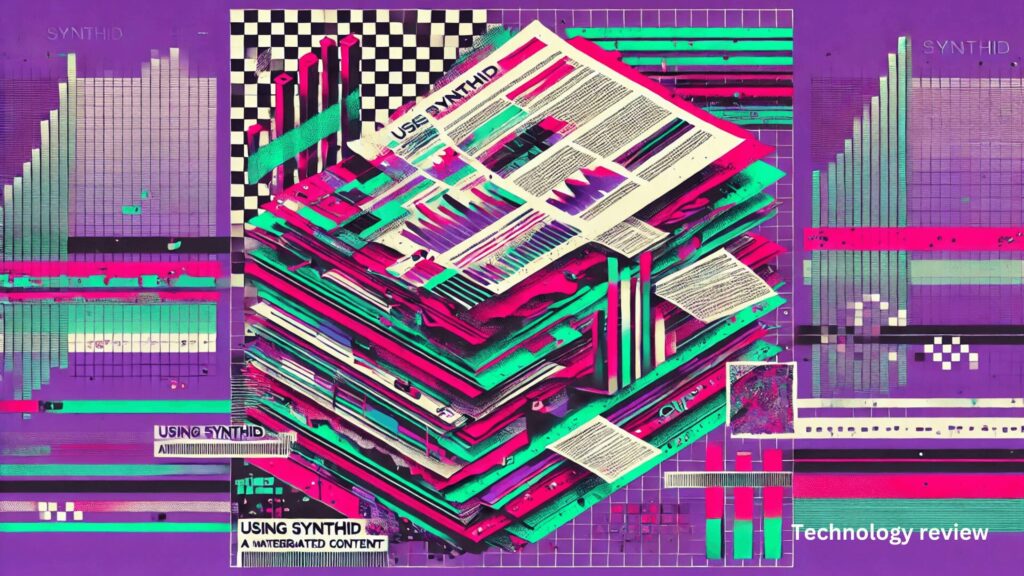Using SynthID to Watermark Al- Generated Content: As artificial intelligence continues to revolutionize content creation, you may find yourself grappling with new challenges in identifying and attributing Al-generated works. Enter SynthID, an innovative watermarking technology designed to address this very issue. By embedding imperceptible markers into Al- produced text and video, SynthID offers you a powerful tool to authenticate and trace the origins of digital content. Whether you’re a content creator, publisher, or consumer, understanding how SynthID works and its implications for the future of media is crucial in navigating the evolving landscape of Al-generated content. This article will explore the key features and applications of SynthID, empowering you to make informed decisions about its use and potential impact on your work.
What is SynthiD and How Does it Work?
SynthID is a cutting-edge technology developed by Google DeepMind to watermark Al-generated content. This innovative tool embeds imperceptible digital watermarks into various forms of media, including text, images, audio, and video, allowing for the identification of Al-generated material.
Watermarking Process
The watermarking process varies depending on the type of content:
- For text: SynthID adjusts the probability scores of predicted tokens during the language model’s generation process, creating a unique watermark pattern across the Al generated text.
- For images and video: The tool adds an imperceptibledigital watermark directly into the pixels, which remains detectable even after modifications like cropping or compression.
- For audio: SynthID converts the audio waveform into a spectrogram, embeds the watermark, and then converts it back to the waveform, ensuring the watermark is inaudible.
Detection and Identification
SynthID uses deep learning models for both watermarking and identification. These models are trained together to optimize accurate watermark detection while maintaining visual alignment with the original content. The technology provides confidence levels to indicate the likelihood of content being Al- generated, helping users understand when they are interacting with synthetic material.

By embedding these digital fingerprints, SynthID aims to promote trust in information and address issues like misinformation or misattribution in an increasingly Al-driven digital landscape.
Benefits of Watermarking Al-Generated Text
Enhanced Content Transparency
Watermarking Al-generated text with tools like SynthID offers a powerful solution for content transparency. By embedding invisible markers, these watermarks help differentiate between human-written and Al-generated content, even after modifications. This transparency builds trust with your audience and maintains high editorial standards.
Mitigating Misinformation
In an era of rapidly spreading information, watermarking serves as a crucial tool for combating misinformation. By allowing platforms to label Al-generated content, watermarks enable users to make informed decisions about the content they consume. This feature is particularly valuable for advertisers and publishers seeking to protect brand integrity and avoid potential safety issues.
Establishing Content Provenance
Watermarking Al-generated text provides a reliable method for establishing content provenance. This capability is invaluable in various scenarios, from scientific investigations to legal proceedings. By clearly indicating authorship and origin, watermarking helps maintain the authenticity and credibility of Al-generated content in professional and academic settings.
Encouraging Responsible Al Use
The implementation of watermarking technologies promotes responsible use of Al in content creation. It encourages transparency and accountability, allowing creators to experiment with Al-generated content confidently while maintaining ethical standards. This balance fosters innovation while addressing concerns about the proliferation of Al- generated material.
Watermarking Al-Generated Videos
Imperceptible Embedding
SynthID, a groundbreaking technology from Google DeepMind, is revolutionizing the way we approach watermarking Al- generated content. When it comes to videos, SynthID employs a sophisticated technique to embed an imperceptible watermark directly into every frame. This watermark is invisible to the human eye but detectable by specialized software, making it an ideal solution for identifying Al-generated video content without compromising visual quality. According to Google DeepMind, this watermarking process is designed to withstand common modifications such as cropping, filtering, and compression.
Audio Watermarking
The innovation doesn’t stop at visual elements. SynthID extends its capabilities to the audio component of videos as well. The system converts the audio waveform into a spectrogram, embeds the digital watermark, and then reconverts it back to a waveform. This process ensures that the watermark remains inaudible to listeners while still being detectable by appropriate tools.
Robustness and Integration
One of the key strengths of SynthID’s video watermarking is its robustness. The watermark can persist through various transformations, including changes in frame rates and color adjustments. This resilience is crucial in maintaining the integrity of content identification across different platforms and editing processes. Currently, SynthID is integrated into Veo, Google’s advanced generative video model, ensuring that all videos produced through this Al are automatically watermarked.
Implications for Content Creators and Consumers
The implementation of SynthID in Al-generated text and video content has far-reaching implications. It empowers users to identify the origin of digital media, potentially curbing the spread of misinformation. For content creators, it provides a layer of authenticity to their work. As reported by Ars Technica, Google has open-sourced aspects of SynthID, making this technology accessible to other developers and potentially setting a new industry standard for transparency in Al- generated content.

Using SynthID to Authenticate Content
Watermarking Al-Generated Text
SynthID, developed by Google DeepMind, offers a powerful solution for watermarking Al-generated text. This innovative technology embeds an imperceptible digital watermark directly into the text during the generation process. By adjusting the probability scores of predicted tokens, SynthID creates a unique identifier that remains undetectable to human readers but can be easily verified by machines.
Robust Detection Across Formats
The versatility of SynthID extends beyond text, encompassing audio, images, and video content. For audio, it cleverly manipulates spectrograms, while for visual media, it embeds watermarks directly into pixels. This multi-format approach ensures that Al-generated content can be authenticated across various mediums, maintaining integrity even after modifications like cropping or compression.
Promoting Transparency and Trust
By providing a reliable method to identify Al-generated content, SynthID addresses crucial concerns in the digital landscape. It helps combat misinformation and ensures proper attribution, fostering a more transparent online environment. For content creators and marketers, SynthID offers a way to build trust with audiences while protecting their work. As Al continues to reshape content creation, tools like SynthID will play a vital role in maintaining the balance between innovation and authenticity.
SynthID FAQs: Common Questions About Watermarking Al Content
What is SynthID and how does it work?
SynthID is a sophisticated technology developed by Google DeepMind to watermark Al-generated text, images, audio, and video content. For text, SynthID adjusts the probability scores of predicted tokens during the language model’s generation process, creating an imperceptible watermark pattern across the text. This watermarking technique allows for the identification of Al-generated content without compromising its quality or readability.
Why is watermarking Al-generated text important?
Watermarking Al-generated text is crucial for promoting trust in information and addressing issues like misinformation or misattribution. As Al-generated content becomes more prevalent, it’s essential to have tools that can distinguish between human-created and Al-generated material. SynthID provides a means to verify the authenticity and origin of content, helping to maintain integrity in various fields such as journalism, academia, and online publishing.
How effective is SynthID in detecting Al-generated content?
Google DeepMind conducted a large-scale experiment with millions of users, finding that the SynthID watermark did not compromise the quality, accuracy, creativity, or speed of the generated text. However, it’s worth noting that the watermark’s reliability may decrease in certain scenarios, such as when Al- generated text has been extensively rewritten or translated.
Is SynthID available for public use?
Google is making SynthID open-source, allowing developers and researchers to test its capabilities and potentially integrate it into their own models. This move towards transparency and collaboration aims to establish SynthID as a standard for detecting Al-generated content across various platforms and applications.
Conclusion
As you integrate SynthID into your Al content workflows, remember that watermarking is just one piece of the responsible Al puzzle. While it provides a valuable tool for transparency and attribution, ethical considerations around Al- generated media extend far beyond technical solutions alone. Stay informed about evolving best practices and regulations in this rapidly changing landscape. By thoughtfully implementing watermarking alongside other safeguards, you can help foster trust and accountability in Al-generated content. Ultimately, your commitment to responsible development and deployment of these powerful technologies will shape public perception and the future of Al-human collaboration.



